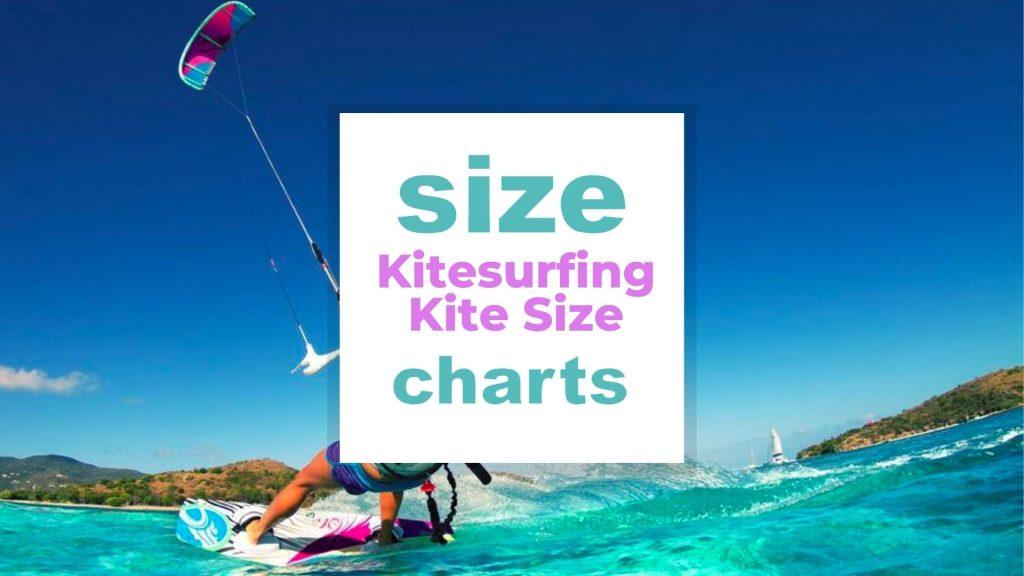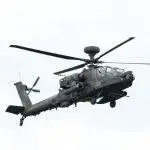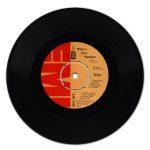What Kite Size do I need for Kitesurfing?
Kitesurfing kite size charts come in many forms. We have built the charts according to the weight of the user. The size of the chart is measured in meters square (m²) and is always labeled on it as a number. In other words, a size 10 kite is simply 10m² in area. Kite sizes span from 3 meters to 20 meters, and kitesurfers will be riding in winds ranging from 6 knots to 50 knots. How to choose the proper size kite is determined by a combination of two factors: wind speed and rider weight.
The wind speed is the most important factor in deciding kite size. A higher wind range needs a larger board and a larger kite. Some freestyle kites can be used for a range of windspeed, but even these kites have their “range” in which they are effective.

The wrong kite size has many disadvantages. Using the wrong size will disturb your control. You will not be able to steer properly and will have poor handling of your motion.
If the kite is too large, its response will be slow and it will feel sluggish. You will spend more time and physical strength controlling your motion. If the kite is too small it will be too responsive and feel rattling.
You will spend more physical strength on staying in one line. Most of the accidents involving kitesurfers have to do with the size of the kite they were using.
Jump right into the Frequently Asked Questions
Related: Roller Skates Size: Find The Perfect Fit, Skateboard helmet size chart and fitting guide, Yoga Ball Size chart for exercising or for your office, Roller Skate Size Chart for Adults and Children, Printable Shoe Size Chart – How do i measure my foot size?
Kitesurfing Kite Size Table of Contents
- Kitesurfing Size Chart For Low Windspeed (12-18 mph)
- Kitesurfing Size Chart For Normal Windspeed (16-24 mph)
- Kitesurfing Size Chart For High Windspeed (22-30 mph)
- Frequently Asked Questions
Kitesurfing Size Chart For Low Windspeed (12-18 mph)
Related: Surfboard Size Guide and Dimensions, Wetsuit Size Chart – Sizing guide for men, women and kids
Low winds have a speed of about 12 to 18 miles per hour, this translates to about 19 to 30 kilometers per hour.
Light winds can be surfed with hybrid kites. Hybrid kites are meant for a range of lighter winds despite having a fixed size. They don’t expand, but they can take in more air in their folds and be used for the widest range of windspeed.
| Body Weight (Ibs) | Body Weight (Kg) | Kite Size (m²) |
| 200+ | 90+ | 17+ |
| 200 | 90 | 17 |
| 180 | 80 | 14–17 |
| 160 | 70 | 14 |
| 140 | 60 | 12 |
| 120 | 50 | 10 |
Kitesurfing Size Chart For Normal Windspeed (16-24 mph)
Related: Kayak Paddle Size by type and height (size charts included), Ski pole size advice with easy to use size charts
Normal kitesurfing wind has a speed of 16 to 24 miles per hour. This is about 25 to 39 kilometers per hour.
Average wind speeds are best suited for a medium kite. Proper-sized kites must provide enough pull and at the same time be stable. “Normal” wind requires a normal kite.
| Body Weight (Ibs) | Body Weight (Kg) | Kite Size (m²) |
| 200+ | 90+ | 17+ |
| 200 | 90 | 14 |
| 180 | 80 | 12 |
| 160 | 70 | 10–12 |
| 140 | 60 | 8–9 |
| 120 | 50 | 6 |
Kitesurfing Size Chart For High Windspeed (22-30 mph)
Related: Foot Size Charts for Adults and Kids: What’s my shoe size?
The wind can be as fast as 22 to 30 miles per hour on the high side. This is about 35 to just below 50 kilometers per hour.
High wind speed is not for intermediate riders. Kite surfing in strong winds needs a larger board, high expertise, and a definitely powerful kite.
| Body Weight (Ibs) | Body Weight (Kg) | Kite Size (m²) |
| 200+ | 90+ | 12 |
| 200 | 90 | 9–10 |
| 180 | 80 | 8–9 |
| 160 | 70 | 7–8 |
| 140 | 60 | 6 |
| 120 | 50 | 4 |
Learn more about what size of kitesurfing kite you would need (video)
Frequently Asked Questions
What size kite do I need for my weight?
Based on your skill level, the size board you will use and how fast the wind is moving, one can arrive at a general size. The factors to consider are so many and some of them may vary even within the same day.
Therefore you can NEVER determine your size based on just rider weight.
What is the normal size of a kite?
A normal size kite is between 8 to 12 sqm. Wind conditions and the material they are made of affect various kites. However, the sizes referred to as “normal” range from 8 to 12-meter square.
What is the best size kite for kitesurfing?
A kitesurfer will always have more than one size, but one very good size to own as an average rider is the 12m² kite. Larger riders also value the 14m² kites.
The size of the kite is not fixed, and you should never use one kite at all times in all conditions. Advanced kiteboarders usually have a signature riding style and quickly realize the kite’s power.
What size kite is best for beginners?
Many kite schools suggest that a beginner kiteboarder can start with beginner kiteboarding kites. This beginner kite is something like a trainer kite and is a good kite size choice as one improves his kite skills.
How do I choose a kiteboarding kite?
Decide on the kite type and what size board you prefer. Measure your weight and determine how fast the wind will move while you are kiteboarding.
Put these two things together to check a kiteboard size chart to pick the perfect size kiteboard. To improve accuracy, a more tech-savvy kiteboarder can find his calculated kite size by using an online calculator.
Are bigger kites better?
This depends on body weight. For heavier riders bigger kites are better, for lighter riders bigger kites are worse. Heavy riders need more pull and so need the extra surface area.
One more thing, a larger kite has more playability than a smaller kite. This means it is easy to get moving and command a larger surface area of the water when you have a bigger kite.
That’s not all. A bigger kite also catches more wind and is therefore easier to use during low windspeed. The extra surface area means that it can garner more power out of the wind than a smaller kite can.
Going back to the original question, in the world of kites is bigger better? The answer remains the same, it all depends on how much power you need to be generating.
How much wind is too much for kitesurfing?
Large, advanced riders can also brave winds of up to 30 mph (50 kilometers per hour). Above this threshold is the danger zone.
To put things in perspective, consider this variety of speeds:
A normal session of kitesurfing for fun requires a wind speed of about 28mph or about 45 km/h.
Speed surfing on perfectly fine flat water with no waves requires a windspeed of about 40mph or about 65 km/h. This is also the maximum and optimal speed for any kite racing. Speeds above this are deemed “overpowered” and are not used by any organization for racing.
Overpowered riding on a normal (average) sized kite, usually 12m requires a peak speed of 44 mph or about 71 km/h.
At this peak speed, the rider can maintain absolute control usually for 3 to 5 seconds. Then he rides the wave, which means, he lets the wind throw him wherever it deems. Then he salvages the situation and heads to safety.
Conclusion
Kite brands might use certain terms to refer to each individual kite model, but there is no known kite meant for kitesurfing that has not been marked in m².
Speed and power depend on the kite and therefore safety and control depend on the rider. Good luck with kitesurfing and sharing this article as you surf the net will be very appreciated.
Picture in this post is by Marcreation on Unsplash
Related to Kitesurfing Kite Size Chart
- O’Neill Wetsuit Size Charts
- Poker Chip Size Guide
- Baseball Card Size Guide
- Bocce Ball Court Size and Dimensions
- Pickleball Court Vs. Tennis Court
- Pool Cue Length – Why it is Important?
- Basketball Hoop Rim Size and Diameter
- Helicopter Sizes and Different Types
- Chessboard Dimensions: What Is The Size Of It?
- Vinyl Record Size and Dimensions
- Ping-Pong Ball Size Chart
- Dolls Size: What Are the Different Sizes of Dolls?
- Baseball Size and Dimensions
- Soccerball Size Guide and Dimensions
- Bocce Ball Size Chart
- Bowling Ball Size and Dimensions
- What is the Size of a Playing Card?
- Basketball Size Guide
- Tennis Ball Size Guide and Dimensions
- Volleyball Size Chart
- Cycling gloves size charts






















